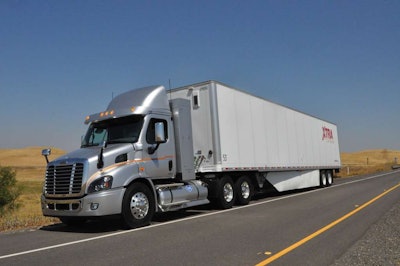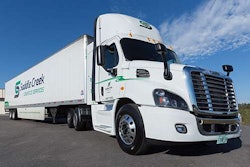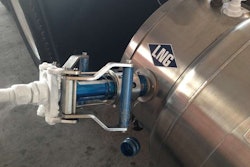 Freightliner’s natural gas-powered Cascadia Evolution
Freightliner’s natural gas-powered Cascadia EvolutionI spent a few days last month in California’s Napa Valley with Freightliner Trucks for a press briefing and a natural gas update, as well as a test drive of a sharp natural gas-powered Cascadia daycab. We had a lot of information thrown at us over the course of three days, including an excellent presentation by Mike DelBovo, president of Lakeland, Fla.-based Saddle Creek Transportation, an early adopter of natural gas.
Saddle Creek runs a fleet of compressed natural gas-powered Cascadias, and DelBovo shared his company’s experiences with us, detailing the decision to go with natural gas and the research and development period that followed, up through the actual implementation of the new fuel and the current state of that effort. Long story short: It’s working for Saddle Creek – and working quite well.
Bob Carrick is Freightliner’s go-to guy when it comes to natural gas, and it was in conversations with both him and DelBovo that an important reality jumped out at me concerning the natural gas push and today’s fleets: If you’re trying to compare natural gas trucks with diesel trucks in order to get some idea of how they’ll perform, just stop – because you might as well compare apples to oranges.
Natural gas 101: What you need know about natural gas
The reality is that diesel remains the perfect fuel for a truck fleet. Its BTU content, its combustion characteristics – heck, virtually everything about it – is tailor-made for truck engines, or really any engine that needs to churn out reliable low-end torque to get its work done. The hard cold truth is that there isn’t a single alternative fuel on this planet – or even on scientists’ radar screens – that ever will perform as well in trucking applications as diesel.
That means if you’re drawing a line down the middle of a sheet of paper and crunching “diesel vs. natural gas” numbers, you’re not accomplishing anything useful. The lesson that Saddle Creek learned – and that Carrick and Freightliner confirmed – is that fleets that successfully implement natural gas operations treat every aspect of the technology as an entity unto itself. Your goal should be to take natural gas and make it work for your fleet, factoring in both its strengths and weaknesses. It’s a totally new and different business model, and that’s the only way it should be approached.
Given diesel’s strengths, the majority of North American heavy-duty fleets will continue to use it as their fuel of choice as long as possible – which means that for all the buzz and showcasing of natural gas trucks you see today, it’s doubtful we’ll see more than 15 or 20 percent of those fleets switch to this technology even after infrastructure issues are resolved and production of natural gas products ramp up to meet increasing demand. I suspect the take rate will be much higher in medium-duty fleets, but that’s a topic for another day.
On the other hand, there are fleets such as Saddle Creek and Abbotsford, British Columbia-based Vedder Transport that have figured out how to run natural gas and do so profitably. Both fleets, by the way, tossed their “Diesel Trucking Rule Book” out the window when they starting evaluating natural gas.
The bottom line: Even if you’re a fleet with no intention of ever adopting natural gas, you ought to be supportive of today’s movement for the fuel – because the more fleets that switch to natural gas, the longer diesel fuel will remain relatively plentiful and affordable.










